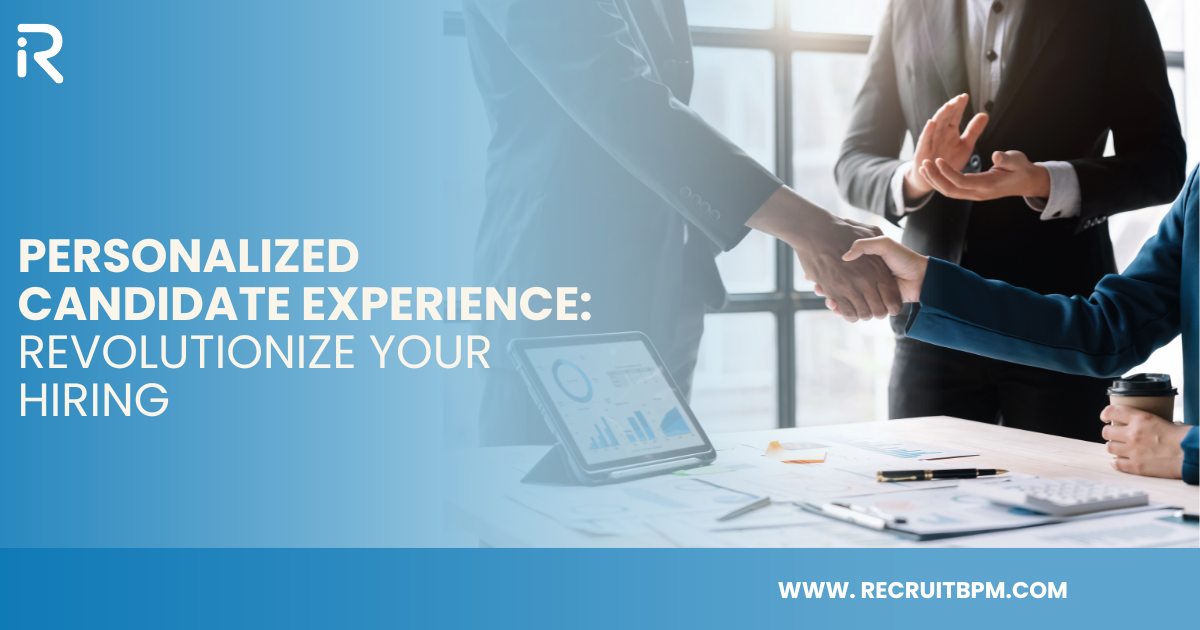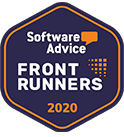Imagine how it feels to land your desired job; it feels magical, doesn’t it? It is a past of a thing when companies could get away with generic application processes and automated responses. Behind that magic lies a carefully crafted tailored personalized candidate experience that matters.
TalentBoard conducted a study recently and unearthed something wonderful – companies spending on tailored hiring practices had an astounding 70% retention rate during the first year. When candidates feel appreciated during recruitment, they are more likely to stay with the organization for longer.
Nonetheless, most corporations fail to recognize that they mistake automation for individualization. Thinking of individual relapses refers to having prior knowledge of every applicant’s personal story; real individualization means comprehending their distinct life experiences. Offering individual preference is not only nice, but vitally necessary.
Indeed, the data supports this claim. A study done by the Harvard Business Review found that candidates with a favorable impression of a personalized experience are willing to refer the company to other people, even if they were not employed, at a rate of two to one. Now that’s some authentic, impactful referrals!
Modern recruitment does not include going through resumes like a pile of papers, rather it revolves around engaging with each and every potential hire. With recruitment, there’s a lot more than merely completing the task. It can lead towards building transformations within the talent pool. It is not merely about filling the gaps; it is about transforming the entire essence of recruitment.
What is a Personalized Candidate Experience?
Recruitment used to involve a lot of waiting and filling forms. Not anymore. The personalized candidate experience shifts the focus on the job applicant to have them as the protagonist of the hiring process.
According to their newest research, Deloitte observes an intriguing phenomenon – companies offering tailored hiring experiences report having 41% more first-year employees stay with the company for over a year. Makes all the sense, doesn’t it? When candidates are appreciated from day one, their chances of being more committed in the future increase.
Reading social cues helps us understand customized experiences go far beyond automated emails or fancy tech. For instance, a candidate indicates employment and you need to set interviews around lunch hours. Or imposing that a person sends detailed previews as opposed to short summaries because the person is detail-oriented.
However, most companies miss the mark when it comes to personalization, as it varies across candidates. Some appreciate daily updates, while others prefer weekly check-ins. Some people perform better on video calls, while others prefer written communication. Getting these details right means making a lasting positive impression.
That’s powerful. It means offering each candidate as an individual pays off whether they join your company or not. A global study by PwC uncovered one thing that was quite impressive. Even rejected candidates endorse companies that provided them unique experiences.
When recruitment processes respect these distinctions, that’s when magic happens. The primary focus should be understanding that every job seeker comes with a distinct set of expectations, skills, and dreams, which, if properly utilized, can create everlasting connections.
The Evolution of Candidate Experience in Recruitment
The job searching process has significantly changed from a decade ago when candidates would submit their resumes only to be disregarded. Before, companies relied upon a universal practice throughout their hiring process and as highlighted by Talent Board’s research, the application drop-off rate stood at an astonishing 80%.
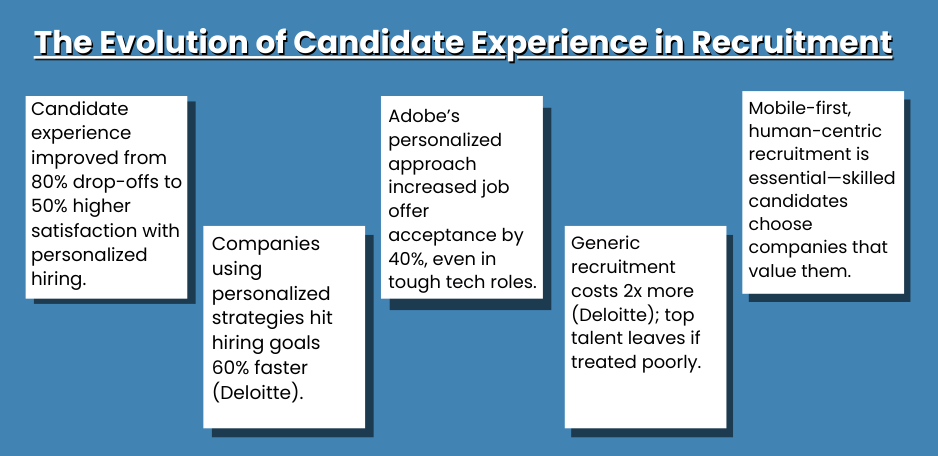
The imperative for candidates to have their experiences customized came about due to the noticeable gap within the industry. In recent times, smarter companies have begun to treat candidates like actual humans, and with this paradigm shift, companies have achieved more positive outcomes. This is further underlined by a pertinent Deloitte study that notes organizations that employ personalized strategies and approaches are able to achieve hiring targets 60% more quickly.
Fifty percent of candidates claiming satisfaction retention with these simple messages is shocking to hear. The World Economic Forum stated that some companies took it to the next level by customizing their welcome texts, while others went as far as allowing candidates to dictate interview times.
Everyone is mistaken when assuming that technology is used by companies nowadays to estimate a candidate’s journey. It might sound superficial, but it is all about humane intentions rather than the unfashionable tools. Companies that stand out use technology for listening, responding, and creating purposeful experiences that matter to each human being.
The optimistic news for all parties engaged in hiring are the innovative employee recruitment strategies which are proving useful in slowly fading away the conventional recruitment methods.
Why Personalization is No Longer Optional
The acquisition of talent has been changing. The one-size-fits-all strategy does not work anymore. According to the latest McKinsey data, organizations can lose up to 73% of their ideal candidates because of ineffective recruitment methods.
Personalized attention during the recruitment process makes a difference, as Adobe found out when they switched to personalized approach last year. Their acceptance rate for job offers increased by 40%, especially within the tech sector where these positions are notoriously difficult to fill. All they did was adjust the communication style to the candidates’ preferences.
Deloitte found something noteworthy in their recruitment research, bigger companies that do not personalize their approach waste nearly 2x more money on filling positions. This is logical because they use too many resources trying to fill positions with the wrong candidates, while other businesses are forming relationships.
This is the key takeaway, top candidates work for companies who treat them well from the very first contact. For example, a software developer receives an email, but it is clearly intended for someone in sales, they check out. A marketing professional is asked questions pertaining to the technical screening, and they too simply move on.
The message from the market is loud and clear. Either mobile or miss out. Most skilled employees make a decision to join a company which is positioned for them, and not just another chain of thought.
The Role of SaaS in Delivering Personalized Candidate Experiences
The advent of smart hiring platforms coming into use has dramatically transformed the recruitment process. Companies are not simply trying to improve the candidate experience – they are doing so, and the results can be measured. Recent findings from LinkedIn suggest that companies which employ sophisticated recruitment technology are able to fill positions at a rate 56% faster than those which do not.
Consider the recommendations that Netflix uses to suggest content to watch. Now think of applying that rationality when it comes to hiring. Candidates’ actions are automatically recorded and modern platforms analyze them. Early risers get early interview slots. Candidates who are meticulous receive job details in great depth. Evening people receive updates in the night.
A recent study conducted by PwC uncovered a rather surprising fact – organizations which utilize smart recruitment technology experienced a 40% increase in offer acceptances. What is the reason? This simple technology started to pick observations where humans failed. Like candidates who saw job updates on their phones all the time, or those who preferred having calls instead of dealing with emails.
The best part? The technology employs automation in such a way that personalization is effortless. Candidates are no longer subjected to generic emails or singular application documents. Every application is customized to fit the candidates’ behavior and preferences.
But here’s the most important thing to recognize – the technology is most impactful when it augments human recruiters rather than replaces them. When recruiters are given insight in real-time regarding which candidates prefer what, the experiences they have with candidates is richer. That is the beauty of it.
Key Features of RecruitBPM for Personalization
Hiring has evolved and so has the candidate experience. With RecruitBPM’s technology, candidates can even expect communication to come in their preferred form, like for example, texts instead of lengthy emails.
The latest data from Deloitte supports this. It shows that personalized outreach gets 52% better response rates than general outreach. RecruitBPM was ahead of the game and noticed it happening sooner than others.
For recruiters who forget the specifics of tedious details such as late-night job browsers, RecruitBPM has thought of everything. Evening updates are automated for those who prefer them, detail-oriented candidates receive comprehensive breakdowns, and quick responders are given fast-tracked scheduling.
TalentBoard did a study and found that 68% of candidates remain longer at companies that made a positive impression on them during hiring. That’s where RecruitBPM’s smart features come into play. The platform’s AI learns from every touchpoint which makes the candidate’s journey throughout the process effortless.
Now, repetitive actions are automated by technology so recruiters use their time creating valuable human interactions. The replacement of human interactions is not the goal, but rather enhancing it.
How RecruitBPM Outperforms Competitors
Platforms that excel at generating personalized experiences for candidates are always a step ahead. A recent study by PwC discovered that intelligent hiring technologies can reduce full cycle recruiting costs by almost 50%.
RecruitBPM has features other platforms do not offer. A tech startup that had previously been responding to 32% of messages saw their response rates increase when they switched over. Why is that? Because their messaging was done at the right time and the style suited each candidate’s preference.
Try to picture how Netflix competes against cable television. With cable, everyone is given the same set of programs to watch. However, Netflix is smart enough to know what you prefer. In a similar manner, RecruitBPM operates. It’s all about every interaction with each candidate. Reports are prepared according to the time of day the candidates prefer to work. Detail oriented candidates receive message replies that contain every piece of detail that is necessary to paint a comprehensive picture.
Platforms such as these simply offer automation services. RecruitBPM assists recruiters in establishing genuine relationships. The platform takes care of answering tedious questions so that real people can engage in meaningful discussions. This combination, according to a recent IBM survey, increases user engagement 2 times because of smart technology together with human interaction.
It completely transforms, and simplifies, the process of recruitment into a conversation, which is an unusual concept these days.
How to Personalize Candidate Experience: A Step-by-Step Guide
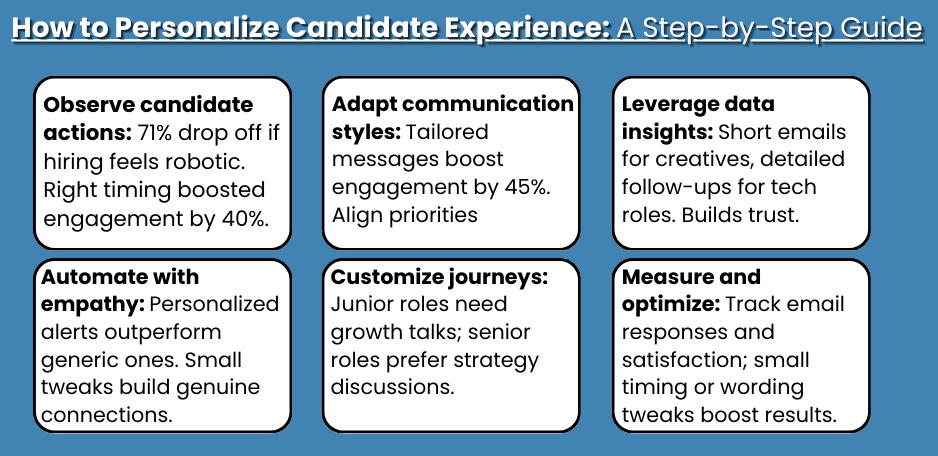
As the title suggests, the first step on how to personalize candidate experience is observing the actions of the candidate. According to research by Deloitte, 71% of candidates tend to disappear from the process of recruitment if it appears to be performed in a robotic manner.
Always make an effort to catch the right timing. Early birds appreciate receiving messages in the morning, while night owls prefer around evening. A certain tech start-up implemented a simple strategy and recorded a drastic increase of 40%. Simple changes can lead to tremendous results.
Adapt to communication styles seamlessly. Meticulous individuals get thorough handouts while swift respondents get succinct briefs. A study from PwC shows this type of adaptation increases engagement by 45 percent.
Check for professional priorities. A person with a development focus? Talk to them about learning programs. Do they seem interested in team culture? Share company stories. Recent evidence from McKinsey validates this – prospective employees are more willing to accept offers when the messages match their interests, by almost a hundred percent.
Let technology take care of mundane activities, allowing more room for real discussions. Monitor engagement levels. If candidates exhibit more interest towards a specific piece of content, repeat it. The latest research by IBM shows adopting this strategy leads to a 33% decrease in the time spent on recruiting.
This misunderstands the most important point – personalization is not mechanical, it is being attentive and responsive. Observe how candidates engage with you, how much you engage with them, and how informal or formal conversations are, and that’s how you create lasting relationships.
Step 1: Leverage Data for Candidate Insights
Focusing on candidate data creates effective, straightforward communication, the information on the applications, work experience, and their online engagement informs us on their preferences and abilities. As candidates are analyzed, recruiters understand what communication style works with each individual. This strategy facilitates meticulous planning and messaging. For example, assessments show that short, clear emails often suit candidates with creative roles, while detailed follow-ups engage technical professionals. Research from Harvard Business Review and experts in Data analytics note that this strategy strengthens relations.
Evaluating candidate trends makes it possible to determine when to adjust messages as well, the structure is important, as is the timing. Changes may be small, but the responses can be dramatic. The process morphs vague communication into tailored messages. Applying these insights helps organizations create authentic and respectful personalized candidate experiences, rather than making generalizations, recruiters adjust to actual behavioral patterns.
This strategy transforms simple engagements into considerate interactions, the strategy makes use of information to determine the most effective method of contacting a person. Tailored communication fills inboxes to the point of overflowing, and this is far from the only effect it has; it also establishes trust and stimulates discussion. This initial investment allows for customization that later facilitates effective hiring and engagement that is sustainable over time and favorable to all parties involved. It is clear how data analysis can streamline hiring processes.
Step 2: Automate Personalized Communication
The use of automated channels gives the feeling of personalization while being efficient. Automated tools can send warm messages via email, SMS, and other forms of communication. These systems allow recruiters to manage countless contacts while maintaining a unique touch to each message. They offer time-saving means while respecting each candidate’s specifics. Changes as simple as including a candidate’s first name drastically enhances the perception of the message. This method clearly illustrates how the blending of technology and care can improve candidate experience.
Systems improvise content based on candidates’ information because of how they learn from previous interactions. Forbes research demonstrates that having personalized alerts performs better in engaging candidates than generic notifications. Automated texts serve as reminders for candidates about an interview. Clear steps and updates are provided through emails. It is always small changes that create a genuine connection, not a routine one.
Every company can benefit from this combination of automation and empathy. Even the most basic of tools can transform standard alerts into a caring moment. The right configuration offers note personalization automatically, without additional manual effort. This level of balance fosters premature trust and streamlines the recruitment process. The automation creating dialogue evokes a caring and lasting impression which is essential if seemingly used intelligently.
Step 3: Create Customized Candidate Journeys
When conversations are insights-driven, devising a specific course for candidates becomes simple. Different roles, levels, and skills warrant their own unique journeys for each candidate. A junior designer may require a candid discussion on growth and mentorship, while an experienced analyst may prefer frank conversations on leadership and strategy. Knowing these differences affect the entire recruitment process.
When the data is clear, it is easier to create a plan. Recruiters can categorize candidates based on their positions and level, and then customize emails, phone calls, or messages accordingly. Paying attention to small details, such as providing relevant materials for the position, creates an impression of real effort. Regular reports and proactive follow-ups bring order to communication without making it robotic. An article from the Harvard Business Review cites research showing that having a clear pathway for a candidate brings them greater personalization and subsequently, higher engagement.
This journey, tailored to each persona, remains supportive of a Great personalized candidate experience for all levels. All interactions, whether they are an email, SMS, or a simple phone call, are important. The approach shows appreciation and builds trust from the very first contact. In practice, it translates to not using an out-of-the-box plan, but instead tailoring the communication to the specific candidate’s profile and their motivations. Such care transforms ordinary actions into remarkable ones in a candidate’s journey.
Step 4: Measure and Optimize Personalization Efforts
The most relevant elements to track that will drive change that matters are the volume of emails sent, tracked, and the number of responses received. Those numbers alone tell a story, and when they are paired with candidate conversations, it is even clearer. The numbers either suggest that something is being done correctly or not. The McKinsey study on candidate engagement index with Touchpoints scoring quantified the candidate interactions.
Responding to candidates is also greatly dependent on what information is sent. Having to constantly monitor allows teams to respond to changes easily. A few tweaks to the timing or wording of messages can greatly change response rates positively. Using KPI’s such as candidate satisfaction and interaction turn out in responses provides clearer guidelines for the content of the messages. This cycle of evaluation dictates changes made within the defined time period set. The aim is to deliver personalized candidate experiences where engagement is simple and mediocre.
The system processes the data and draws actionable feedback. It transforms values and ratios into practical suggestions. Incremental routine evaluations enable teams to progressively improve their strategy. With precise computation, even the smallest enhancements can be significant. Each step of the journey is dynamic and responsive, efficient yet human, because of the continual assessment and adjustment completed in every step of the process. Consistently observing these metrics opens the door for effective, continued personalization.
The Psychology Behind Personalized Candidate Experiences
Personalization invokes emotion in ways that are often unnoticed. When a candidate receives a communication that reflects their unique experience, they feel appreciated and included. A note that goes beyond relaying information, for instance, a detail that stems from the candidate’s interview builds stronger trust. A Personalized Candidate Experience is not limited to standard communications. Such messages stress the point that every candidate matters. This little act of compassion can shift emotions and nudge decisions.
The candidate’s interests and strengths resonate with them, making them feel as though they have a voice. No longer do they perceive themselves as just another statistic; rather, they have their own narratives. For example, in a sample of a personalized candidate experience, an email may commemorate a candidate’s project accomplishments or bring up skills that were noted during a conversation. This kind of attention translates to recognition and appreciation and helps to alleviate the pressure felt while searching for a job, and the fear of being just another number in a large pool of applicants.
Short, simple, but well-thought out messages welcome the recipients in a more friendly manner. Such messages move away from the generic unsolicited mass emails that many companies still use. Rather, these messages allow candidates to feel as though they are being treated with deliberate kindness. As the Harvard Business Review states, emotional appeal is proven to be more rational in its outcomes. Seeing and hearing something positive triggers a response, rather than indifference.
Every targeted message does more than convey information- it triggers a visceral response. Such a response is likely to have a positive impact on a candidate’s impression of the company and participation in the hiring process. It dissipates the anxiety and paves the way for candid conversation. This mixture of information and feeling utilizes the deep-seated desire to be appreciated. A recruitment process that seeks to meet the expectation of candidates need not be very elaborate as they already have reason to gain appreciation. The approach changes from being simply functional, to being more emotional and relational.
Customized approaches offer greater clarity. When organizations incorporate these additional details, they begin to notice an increase in the quality of candidate engagements as well as overall company image. Recruiters combine basic data analysis with emotional messages to create a new, more truthful communication. This method transforms the hiring process into an experience where both sides feel heard. Now, with emotional connection as guidance, candidates hope for a brighter and less stressful way to move forward.
Humans are social beings, always on the look for genuine engagements. Every personalized message and detail makes it easier to build rapport for future engagements.
Why Candidates Respond Better to Personalization
Personalization plays on thoughts and emotions. Response to messages that are tailored to real interests evoke emotions. Factors like reciprocity also come into play. A thoughtful message makes candidates willing to respond kindly in return. Simple acts of kindness lead towards more willingness to respond and be engaged.
Candidates also value the sense of community. Messages that speak to a candidate’s qualifications or interests can make them feel personally appreciated. This recognition helps foster more meaningful engagement. Candidates do feel that employers look after them and not just CVs on files. Such dynamics Enable Creating ‘A Great Personalized Candidate Experience’. that is Personalised and has a touch of honesty.
Messages that are clear and to the point cut through the clutter created by generic emails. Simple things such as mentioning a candidate’s previous job or career goal make a difference. These small gestures create a feeling of trust. The person applying may fit in the category of prospective employees, but above all, he or she is appreciated. Research shows that feeling special makes most people want to make known their views. For example, McKinsey research confirms the impact of personalized communication on application response rates.
Fundamentally, candidates appreciate communications that demonstrate sincerity. When personalization involves mutual goodwill and participation, the responses are not only quicker, but also deeper in substance.
Overcoming Challenges in Personalizing Candidate Experiences
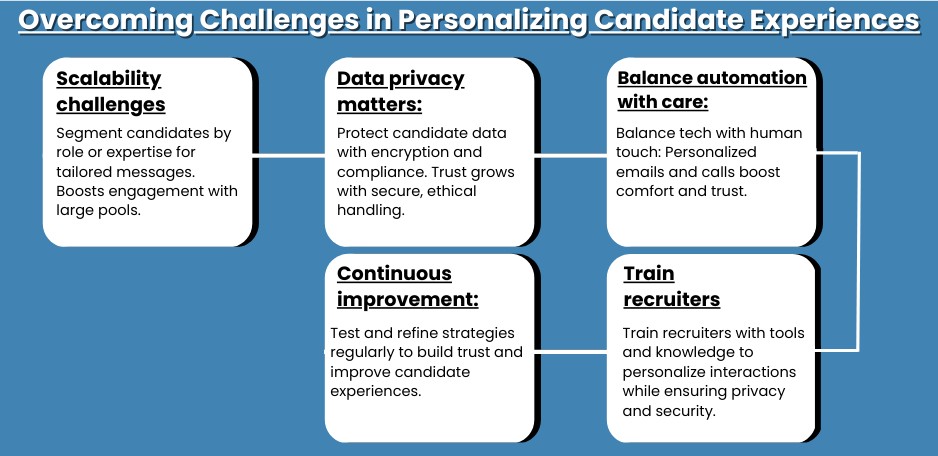
Making personalized candidate experience for every candidate whose application is being processed is challenging. Each Candidate must feel that every message was crafted specially for them. Recruiters have their fair share of challenges too.
One of the most difficult challenges is scalability. Although in some smaller companies, every candidate might seem like they are being treated on a personal basis, as the numbers increase, there is a risk of falling into the trap of sending out bulk emails. This issue can be resolved by the use of modern technologies which can screen candidates based on their job title, rank, or specialization. Dividing a large population into smaller subpopulations allows the creation of tailored messages for a particular candidate’s context. Engagement is known to improve when there is segmentation and streamlined communication according to McKinsey, even though the numbers may be overwhelming.
Another big challenge is protecting the candidates’ information. While it’s helpful to have information, it needs to be treated with caution. Trust can be destroyed at any moment and a breach can be damaging. Strong security, like encryption and audits, should be put in place. Regular checks help to ensure privacy in the recruitment process and do not hinder the flow of things. Apart from legal ground, all these moves ensure that the candidates are treated with respect and that their data is safe.
Dealing with these challenges requires an intersection of technology and humanistic commitment to actual interaction. Some of the practical changes that can be implemented are as follows.
- Implementing segmentation that divides a longer list of candidates into more manageable and targeted groups so they can be issued relevant information.
- Using automation that is able to tailor a message to the recipient’s position and expertise level instead of sending mass emails.
- Providing comprehensive training and updating security is essential to ensure that recruiters are up to speed in these data privacy best practices.
Training is crucial as well. With proper education and tools, the candidates are treated with a little more respect and a more personalized approach. Education and refreshers over personalization and data manipulation empowers every participant to make each interaction purposeful.
The goal is clear. Every message should feel personalized and secure, and this is possible even with numerous candidates. It is all about balancing thoughtful use of technology with basic human care. Careful, slow reworking and testing of strategies builds trust over time. While there are bound to be bumps in the process, every small win takes us closer to an improved quality of the Personalized Candidate Experience. Through the right mix of tools and persistent effort, challenges can become opportunities for a more engaging and respectful hiring process.
Balancing Automation with Human Touch
Simple tasks become easier to manage with technology, but building trust requires a human touch. This is the secret to how to personalize the candidate experience, blending technology with personal touch. The integration of automated systems allows for efficient management of numerous contacts at once. Updates, reminders, and alerts can be sent automatically with incredible speed and accuracy. A fully automated approach can sound cold. Each candidate has unique needs that require simple, caring touches. Smart tools combined with genuine human care is what the recruitment industry needs.
Imagine a case where a candidate receives a prompt email update due to automation and simultaneously gets a follow-up call from a recruiter who wishes to speak to them personally. This combination ensures the candidate feels appreciated as an individual. According to research by Forbes, small gestures increase a person’s comfort and encourage them to engage more. An open and honest gap is mandatory, though.
Warmth is generated through personalized templates and occasional direct outreach. A candidate’s mood or tone is often beyond the grasp of the system, which is why someone needs to manually step in to aid the machine. Striking the right balance means combining compassion with efficiency. There is thoughtfulness in every automated interaction, which makes it more genuine. This proves that even in environments where a large number of interactions take place, candidates are valued. Trust, a sense of connection, and caring are created and the process becomes something to look forward to. Trust, however, is one of the most important elements of success.
Ensuring Data Privacy and Compliance
The trust of candidates is effortlessly built and maintained when a company maximizes the potential of candidate data in an ethical and lawful form. Each interaction must ensure that the personal details of each individual is safeguarded while data is used to deliver personalized candidate experiences. Best practices start once policies and systems are established to safeguard data while complying with GDPR and CCPA legislations. These consist of steps such as data encryption, access control, and regular vulnerability assessment scanning.
These requirements will also be in collaboration with other divisions such as Information Technology and the legal division to formulate a practical policy regarding data collection and usage. There is a degree of education that is required for staff members concerning the privacy and confidentiality policy for the purpose of maintenance compliance. This, combined with the trust candidates can have knowing how their data is collected, retained, and disposed of is enough for candidates to feel more confident about trusting the company. Candidates will be further assured that their sensitive information is dealt with securely which removes the risks associated thanks to secure communication and storage platforms.
Through continuous evaluation and alterations of such protocols, a business is able to ensure that its privacy policies align with shifts in regulations and technological progress. Establishing such a protective framework in order to comply with legal standards only enhances the entire recruitment process by better funding technology and training.
In the end, this is pretty broad for data neutrality. They need to get that on the very first step of doing something with the candidates, deliver personalized candidate experiences that would need to be tailored.
Best Practices for a Great Personalized Candidate Experience
The most important part is to strike the perfect blend of thoughtful strategy and truly human touch when crafting a Great personalized candidate experience. Here is a guide for recruiters wanting to understand how best to implement personalization:
- Get to Know Your Candidates:
Spend some effort understanding candidates’ backgrounds, skills, and goals. After gathering meaningful intelligence, through good profiles, one-on-ones, or focused questionnaires, the candidates can be grouped by topics that they are least bothered about. This high-order taxonomy approach is vital in making every text written relevant, which makes the candidate feel important right from the start.
- Combine Automation with a Human Touch:
Mass communication is usually burdensome; however, technology can manage it well. A personal touch is still unmatched, as with video calls, sending an automatic email and following up with a phone call, or even better, a handwritten note makes the recipient feel special. A simple piece of bespoke communication makes it look like you do not belong to the herd.
- Diversify Your Communication Channels:
Different candidates engage better with different platforms. Some like reading their emails while others respond faster to social media alerts or SMS. Go for a multi-channel strategy and adjust your communication style. Not only does this make engagement highly likely, but it practically serves to appreciate the candidate’s preference and further strengthens the rapport.
- Invest in Continuous Learning:
The personalization is still in development within itself. Personal trainer workshops show more and other ways how to enhance candidates engagement within the team. Not only that, but sharing all the success stories alongside the barriers within your team allows for skill sharpening, thereby developing a culture of doing so differently and celebrating innovative personalization solutions.
- Monitor, Measure, and Adapt:
Feedback is in fact the most trustworthy source of information. Do not forget to monitor the open rates, response rates, and form reports during metrics—these will dictate how you spend your time strategically. Whether you are modifying your email templates or changing the timing of the follow-ups, ensuring there are steps that have been deduced as a result guarantees that the user experience will always ‘remain’ refreshing.
By integrating these actionable steps, recruiters can transform routine interactions into engaging, bespoke experiences. Embracing a strategy that values both efficiency and genuine care will set the stage for a Great personalized candidate experience that not only attracts top talent but also builds lasting trust and loyalty.
Use AI and Machine Learning Wisely
Automating AI and incorporating it into your recruitment process is all about achieving the objectives efficiently while still adding a human touch. As you think of ways of how to personalize candidate experience, consider that AI does most of the work, such as scanning resumes and spotting patterns, so your team can focus on building relationships. For instance, machine learning can quickly sift through a candidate’s information and show you how to subdivide the pond into smaller fish bowls based on various skills or interests. You are now able to think about how you would like to personalize your follow-up messages or arrange the time for a personal call.
The potential of AI is best appreciated when it sets human beings’ needs free. Virtual assistants are able to save time by performing many basic functions because they make it possible to do deeper work with each of the candidates. This blend makes it possible for each specific interaction to draw from data, and genuine human emotion at the return. You do not give technology control; on the contrary, you empower every single conversation with technology.
Ultimately, blurring the lines between automation and human infliction transforms the recruitment processes such that every candidate feels different. Continuous AI tweaking and responding to feedback will ensure that your team is always giving dry yet warm encounters.
Continuously Gather Candidate Feedback
Adapting and improving a candidate’s experience relies heavily on taking their thoughts and opinions into consideration. The system of establishing regular feedback loops following interviews through brief surveys, follow-up calls, or forms gives you insight into how to effectively and meaningfully connect with each candidate.
Such feedback is important because it indicates what is working and what areas need attention, each comment serves as a useful marker guiding how and when to communicate with candidates. When candidates provide employees with honest feedback, it becomes apparent what the candidate is enjoying as well as what needs adjustments. As a result, a flow of ideas is created over time to ensure strategies used throughout the process feel respectful, and personal.
Once the feedback is captured, analyzed and executed, employees are more likely to adjust to changing demands. As a result, the hiring experience transforms into an elaborate voyage with beautifully crafted touchpoints, every engagement surpassing the candidate’s expectations.
Final Thoughts
Regardless of how recruitment may shift in the future, the core of successful talent acquisition remains constant: a truly Authentic, Personalized Candidate Experience. Looking back on our journey thus far, there are a few notable observations. First, the integration of modern technologies such as AI and machine learning with personal, human touch not only improves operational effectiveness, but also strengthens the emotional connection recruiters have with candidates. It is this equilibrium that guarantees that every candidate perceives himself or herself as a person worthy of admiration and appreciation, not just another number in a database.
Additionally, it is critical to ensure strong data protection during the curation of personalized messages. This collection of practices illustrates the importance of setting proper data privacy boundaries and collecting information as feedback on a continuous basis. Such steps enable recruiters to improve their approaches in real time, making certain that every interaction reflects the candidate’s individual story and needs.
We can clearly see the shift in the recruitment landscape towards the use of more integrated platforms. This is where RecruitBPM steps in. RecruitBPM automates entire processes with smart technology while still caring for the human element of recruitment; It provides modern recruiters with a perfect system that enables them to scale as their personal touch with candidates expands. Every interaction is not only driven by data, but also infused with emotion and understanding that only a human being can provide.
All of this goes to prove that the future of personalized candidate experiences will rely, even more, on the intersection of technology and humanity. As the modern day recruiter incorporates the most practical approaches and innovative tools, he or she is able to gain trust, enhance the recruitment process, mitigate risks of losing the right talent, and all that while providing an astounding Personalized Candidate Experience that is so difficult to compete with now and in the future.
Transform Your Hiring with RecruitBPM
Are you set to take your hiring process up a notch? RecruitBPM has prepared a platform that combines deep analytics and a human’s authentic touch to help you achieve a Personalized Candidate Experience. Our user-friendly platform allows you to book a demo or begin your free trial right away and see for yourself, how our novel approach to recruitment transforms hiring.
Now, you can enjoy the best of both worlds: where technology enhances the touchpoints and direct communication fosters real relationships. Take a step into the future of hiring and notice how every interaction with the candidate is enhanced.
Enjoy a better hiring experience with RecruitBPM today and see how effortless and engaging recruitment becomes as you let your hiring stand out from the rest.
FAQs
What precisely is a “Personalized Candidate Experience”?
Personalized candidate experience is the customization of every interaction for a specific candidate’s needs, preferences, and skills. This approach, beyond all ordinary communications, proffers great value as it creates significant touchpoints whether through individualized emails or personalized content, that makes candidates feel cherished throughout the journey.
What are some best practices for delivering a great personalized candidate experience?
The blog outlines quite a number of practical tips and among them is: creating a candidate segment that is profile based so that communications stay relevant.
Adding an automated process with human interaction to make sure efficiency is achieved without compromising on warmth. Veteran staff and junior staff have first contact outreach over multi-channels to make sure no single submits information in a single medium. Workforce training for the whole team to make sure everyone is up to speed with the latest personalization techniques. All of these practices put together form a more engaging and customized recruitment process.
How can AI and machine learning enhance personalization without losing the human touch?
The use of AI and machine learning can collect an unfathomable set of information on candidates and provide sifting automation for implementing boring tasks like scheduling meetings or first contact communication. The trick is to make sure that using these systems tries to augment human interaction instead of replacing it. By using the gathered data, recruiters have the ability to pay more attention to meeting a person’s authentic follow up that will enrich a relationship.
Why is continuously gathering candidate feedback important?
Continuous feedback gives enough data to adjust and refine personalization on the recruitment process. By collecting data through surveys, interviews, or forms, recruiters are able to quickly know what’s working and learn what can be improved. This maintains a conversation which in turn guarantees that the recruitment process proactively adapts to candidate needs.
How do human interaction and technology work together to create an outstanding candidate experience?
The blog states that technology and the human touch do not cancel each other out. It automated the processes of data harvesting, candidate categorization, and routine communication, thus allowing recruiters to focus on building real relationships with candidates. When technology’s personalized insights are combined with human features, the recruitment process becomes meaningful and efficient with every candidate.


